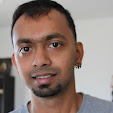
Nevertheless, we planned a trip* and almost 7 hours & 1,094 km later I was in the middle of nowhere: Gavray.
| *Trip | 7 hours & 1,094 km |
| A. Train from Aix to Paris | 3 hours & 758 km |
| B. Waiting time on Champs Elysée | 1 hour |
| C. Train from Paris to Gavray | 3 hours & 336 km |
Overview of Gavray:

In summary, Gavray is a small village with: cows, horses, donkeys, lots of nature, no internet, no buses, no people, and farm girls. :) [OK, that's maybe a little bit of exaggeration, but one gets the point]. The population is around: 1,678 people in 2005. Wow!
Overview of Normandy:

During the Battle of Normandy in World War II, Normandy became the landing site for the invasion and liberation of Europe from Nazi Germany. This is recognised as a turning point for the war in Western Europe. It's for this reason that's it's quite famous, and it was even more interesting for me to be there at the same time that President Obama was there for the commemoration of D-Day.

Overview of Trip:
[click on the bolded-title-links for more pictures]
 French Sunday Lunch: A 3-hour long lunch including: aperitif, appetizers [or as we say in Trini: "cutters"], main course, dessert, wine, champagne, family, friends-of-the-family, and a 2-hour long promenade [after-lunch-walk], on the cold beaches of Normandy. We actually swam there, that day, uncannily freezing.
French Sunday Lunch: A 3-hour long lunch including: aperitif, appetizers [or as we say in Trini: "cutters"], main course, dessert, wine, champagne, family, friends-of-the-family, and a 2-hour long promenade [after-lunch-walk], on the cold beaches of Normandy. We actually swam there, that day, uncannily freezing. La Baleine: A refreshing walk into the wilderness of the small village of La Baleine [the whale]: trees, cows, horses, rivers, small churches, English-country-side-houses, and an Andouillerie [a fumerie, where they smoke and cure pig intestines filled with chopped-up pig intestines and stomach, to create an appetizing "sausage" called "Andouille"].
Gavray's Sheep: I never really saw sheep like this until I came to Europe. Maïté's dad was trying to explain some stuff about them and the terrain around. The beaches just beyond actually look beautiful here.
- Le Château de Fougères & Mont Saint-Michel: This day we visited a Medieval fort of Fougères and the famous Mont Saint-Michel. Fougères is a commune of the Ille-et-Vilaine department in Bretagne in north-western France. Here, a medieval fort is built atop a granite ledge, which was part of the
ultimately unsuccessful defence system of the Duchy of Brittany against French aggression. Le Mont-Saint-Michel is a rocky tidal island and a commune in Normandy [this is often frowned upon by "Bretagnians"]. It is located approximately one kilometre off the country's north coast, at the mouth of the Couesnon River near Avranches. The population of the island is 41. On this day, we also visited the Pointe du Grouin [the rocky finger that points out and protects the entrance into the bay of Mont Saint Michel] and the picturesque fishing village of Cancale also known as the "oyster capital" of Brittany.
Chateau de Gavray: Basically it's not a castle, it's the ruins of a castle; I climbed all this to see some crumbled rocks; but the sunset and the stray dog we found were nice. On top of a steep-sided hill that dominates 'Vallées de la Sienne et de la Bérence', stood at an imposing medieval fortress: Le Château Ducal de Gavray. Its location at the crossroads of routes from Caen and Nord Cotentin, which led to the Mont Saint Michel and Brittany, was a strategic point of interest. It is why the Dukes of Normandy had chosen the site of Gavray as a seat of viscount and had established this castle, for military purposes.
Granville: Maïté drove us there: first time I saw her driving [manual car]. It's a nice port-town, where the beach tides recede super-fast and very far-out during daytime, and advance all the way up to the port-side at night. The old town of Granville preserves all the history of its military and religious past. The lower town was partly built on land reclaimed from the sea. The upper part of the old town is surrounded by ramparts from the fifteenth century. These are entered through the drawbridge [Grand'Porte], the bloody theatre of the "Siège des Vendéens" in 1793.
It was a very relaxing, inspiring, and well-deserved trip after a long and tiring thesis. It allowed me to discover another side of France: another landscape, another culture, another language, another history, and another adventure…


